Key takeaways:
- Strength and flexibility are crucial for breakdancing success, enhancing muscle control and stamina.
- Core strength exercises like planks and Russian twists improve balance and stability during performances.
- Upper and lower body strength exercises, such as push-ups and squats, refine transitions and add fluidity to dance movements.
- Consistency in training and integrating exercises into warm-ups can significantly boost dance performance.
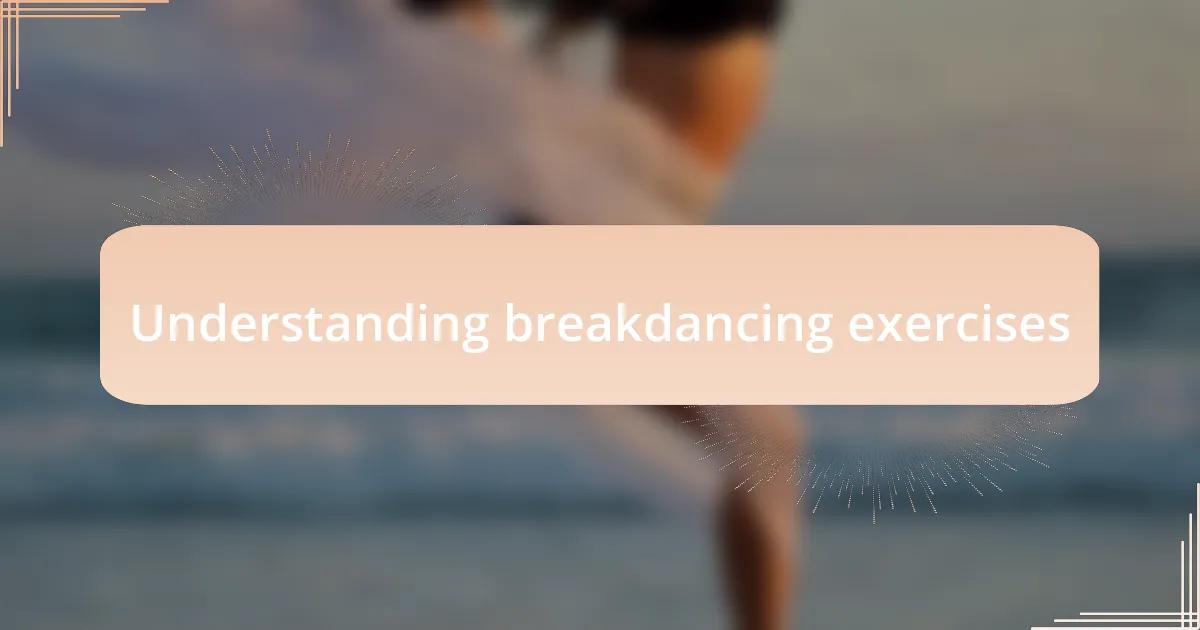
Understanding breakdancing exercises
When I first started breakdancing, I quickly realized that technique alone wouldn’t cut it; I needed a solid foundation of strength and flexibility. Exercises tailored to breakdancing not only enhance my muscle control but also boost my stamina, allowing me to execute moves that once felt impossible. Have you ever felt that satisfying burn in your muscles, knowing you’re pushing past your limits? That’s the moment when strength-building exercises truly pay off.
Understanding breakdancing exercises goes beyond simply toning muscles; it’s about fostering the body’s coordination and agility. I remember practicing my spins and freezes, often frustrated by how my body didn’t respond the way I wanted. But then, incorporating core exercises and balance drills transformed my movements, making them smoother and more powerful. Can you relate to that journey of trial and error? It’s all part of the dance.
In my experience, I often blend traditional workouts with b-boy specific drills, which effectively bridges the gap between general fitness and dance-specific strength. From shoulder taps to squats, I love how each exercise feels both like a workout and a dance practice. The direct connection between these exercises and my performance on the dance floor is incredibly motivating; it’s thrilling to see the results firsthand when I nail that windmill after a dedicated strength session. What are your go-to moves that need extra muscle for that added flair?
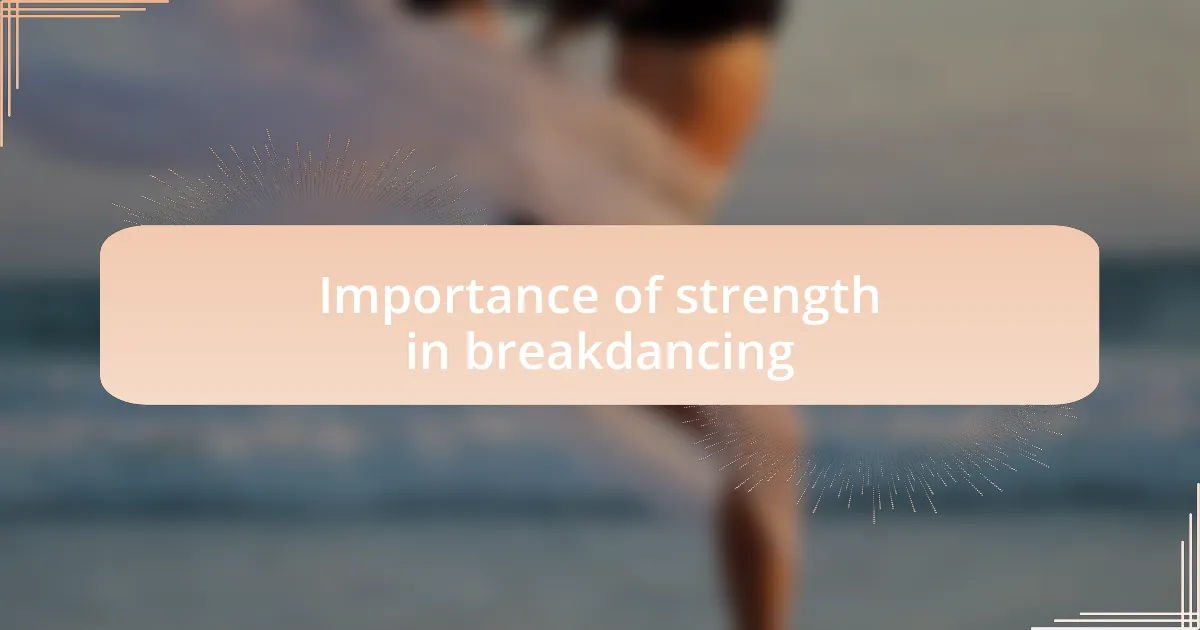
Importance of strength in breakdancing
Strength is a critical component in breakdancing because it allows dancers to execute difficult movements with greater ease and precision. I vividly recall my first attempt at a headspin; I lacked the upper body strength and ended up crashing to the ground more times than I could count. Those moments were frustrating, but they taught me that true mastery comes from building that essential strength to support my body in complex maneuvers.
Moreover, having a strong core is not just about aesthetics; it fundamentally affects my balance and control during performances. I distinctly remember the breakthrough I experienced during a practice session when I focused solely on core exercises. Suddenly, my transitions between moves felt effortless, and I found myself transitioning into freezes with a newfound stability. Have you ever had that exhilarating moment when everything just clicks? It’s all about building that strength to support your artistic expression.
I’ve also learned that strength training can enhance recovery and reduce injury risk while dancing. The intense demands of breakdancing can take a toll on our bodies, but I’ve found that incorporating strength exercises has made a world of difference. After a tough practice, I feel more resilient and ready to take on the next challenge. Doesn’t it feel empowering to know that by strengthening our bodies, we’re also ensuring we can keep dancing for years to come?

Exercises for core strength
When it comes to building core strength, I’ve found that planks are a game-changer. Holding a plank position not only engages the abdominal muscles but also activates the shoulders and back. I remember setting a timer for just 30 seconds during my early training sessions; it felt daunting at first. But gradually, I increased the time, and I was amazed at how this simple exercise transformed my stability and controlled my movements during dance battles.
Another core exercise that truly resonates with me is the Russian twist. As I sat on the ground, twisting from side to side with a weight in hand, I could feel the burn in my obliques. This exercise has taught me to embrace discomfort as part of growth. Have you ever felt that sense of accomplishment after pushing through a tough workout? The impact this has had on my ability to maintain balance during spins and freezes is incredible. It’s almost like discovering a new dimension to your dance.
Finally, one of my favorites is the hollow body hold. This move requires you to flatten your back against the ground while lifting your legs and arms, creating a sort of banana shape. When I first started practicing it, I struggled to maintain the position for more than a few seconds. However, with regular practice, I’ve noticed that this has not only strengthened my core but also improved my overall agility when executing tricks. It’s amazing how something that seems so challenging can lead to breakthroughs on the dance floor. Wouldn’t you agree that when we push our limits, we discover our true potential?

Exercises for upper body strength
One of the exercises that has significantly boosted my upper body strength is the push-up. I remember struggling to complete even a few reps when I first started, but with persistence, I gradually built up my strength and confidence. The feeling of pushing myself off the ground and feeling my chest and arms engage is exhilarating. Have you ever noticed how every time you push through a challenging set, you feel more empowered in your movements?
Another incredible exercise is the dip. When I first tackled this move, I was surprised at how much it activated not just my triceps but also my shoulders and chest. The burn I felt while lowering and pushing myself back up was a reminder of my body’s potential. It’s fascinating how something so simple can make such a profound difference in grip strength during tricks like freezes. Have you experienced that moment when you realize your body can handle more than you thought?
Lastly, I can’t emphasize enough the power of performing handstands. Initially, I was intimidated by the thought of being upside down, but once I embraced the challenge, it transformed my upper body strength and balance. Focusing on maintaining my alignment taught me not just about strength but about finding my center of gravity. Isn’t it incredible how stepping out of your comfort zone can enhance your dance skills in such a fundamental way?
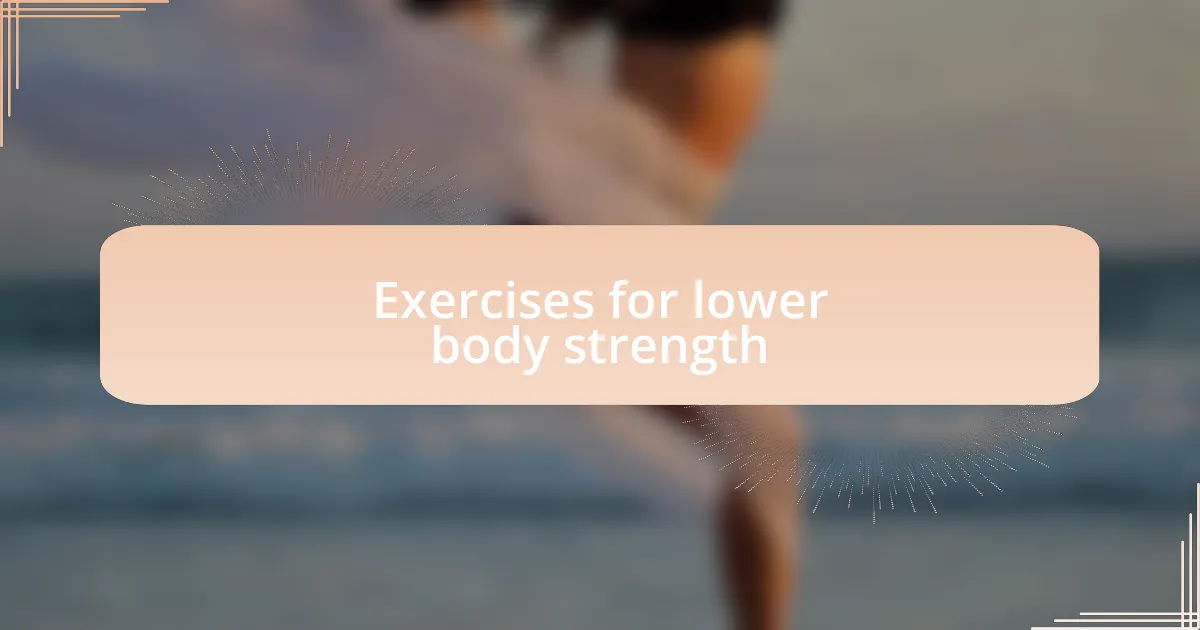
Exercises for lower body strength
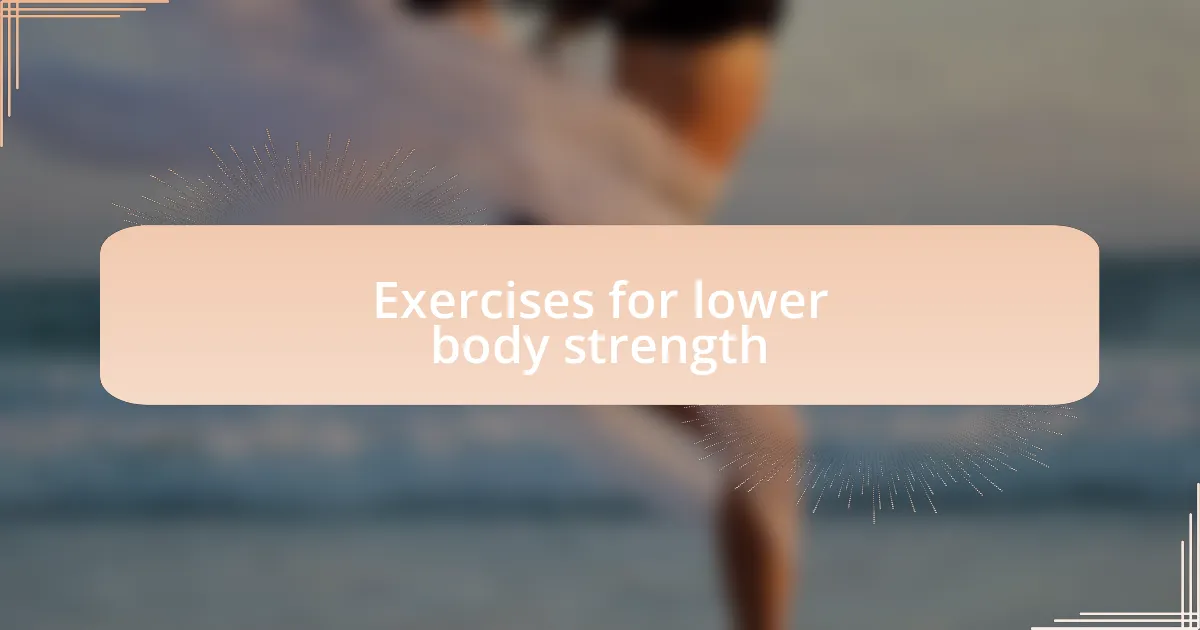
Exercises for lower body strength
One of my go-to exercises for lower body strength is the squat. I remember the first time I held my weight in that position. It felt awkward, but as I sank down, I could feel my glutes and quads working hard. Have you ever experienced that moment when you realize you’ve progressed from struggling to holding deeper, more controlled positions? It’s a game-changer for balance in moves like toprocks and footwork.
Another essential exercise is the lunge. I still recall how my legs quaked the first time I pushed through a set of lunges. Each step forward required not just strength but also stability, which is crucial when transitioning between moves. It’s a reminder that building lower body strength is about more than just brute force; it’s about control and precision, wouldn’t you agree? This exercise has truly refined my transitions and adds fluidity to my dancing style.
Lastly, I can’t overlook the importance of calf raises. At first, I thought they seemed trivial, but they’ve made a significant impact on my agility. There’s something about the way my calves engage, giving me an extra pop during explosive moves. I remember the pride I felt when I could finally perform a clean jump with the height I craved; it really opened my eyes to how interconnected strength is across all muscle groups. How does it feel to discover the strength in the smallest muscles that often go unnoticed? It’s pretty empowering, isn’t it?
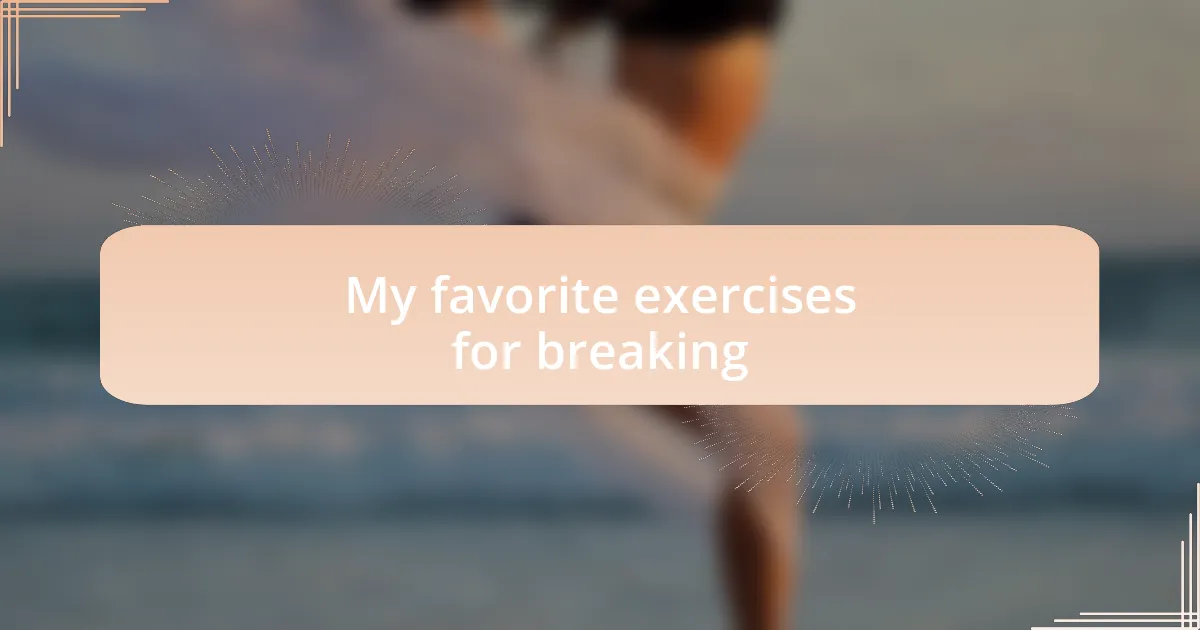
My favorite exercises for breaking
One of my favorite exercises for breaking is the hollow body hold. I vividly remember the first time I tried it; my core felt like it was on fire! There’s something incredibly rewarding about mastering that balance. It not only strengthens my core but also helps with maintaining body control during freezes and spins. Have you ever found a position where you just felt completely in control? That’s the magic of the hollow body hold.
Another standout in my routine is the leg raise. I always felt a bit awkward doing them at first, but the results are undeniable. I still recall the excitement when I could lift my legs fluidly, engaging my hip flexors and abs simultaneously. It’s really fascinating how this exercise translates into powerful kicks and enhances my overall line. Wouldn’t you agree that finding that kind of strength gives you a deeper connection to your movements?
Lastly, I can’t skip over the impact of power push-ups. Trust me, I didn’t think they’d be a favorite when I started. Remembering the frustration of getting off the ground feels like a distant memory now. The explosive energy I generate from these push-ups not only boosts my upper body strength but allows for those explosive transitions that breakdancing demands. It’s exhilarating to feel that power—and honestly, isn’t it energizing to push your boundaries each time?
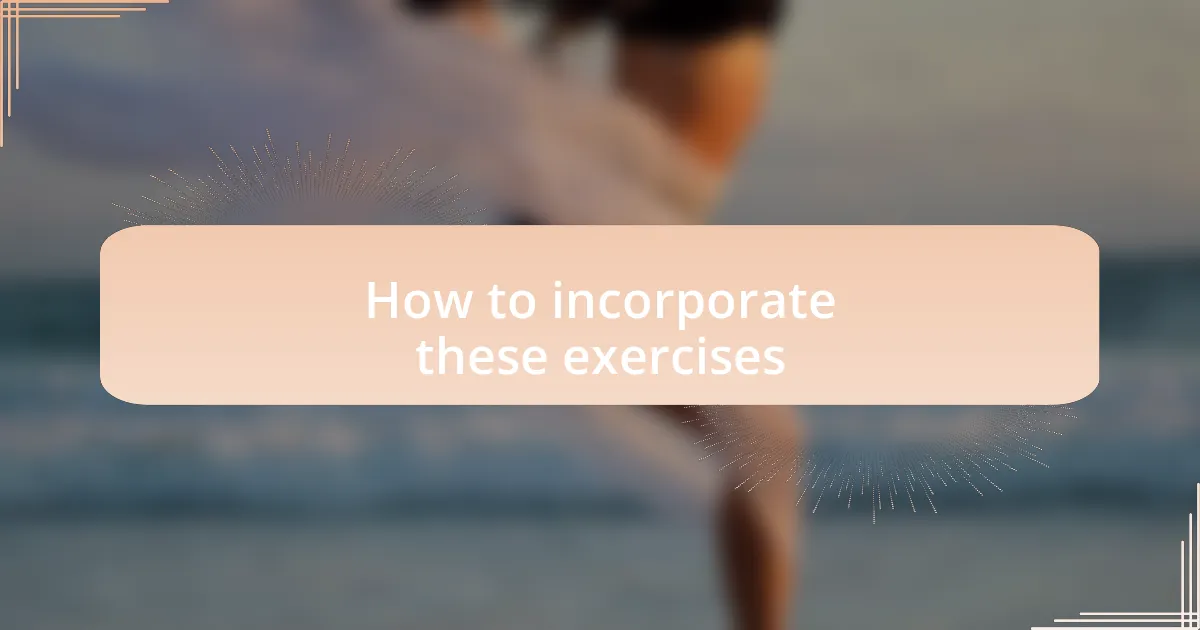
How to incorporate these exercises
To effectively incorporate these exercises into your breakdancing practice, consistency is key. I remember setting aside specific days just for strength training, which helped me look forward to improving my skills. It was transformative to see how dedicating even half an hour, a few times a week, made a noticeable difference in my performance on the dance floor—have you experienced that kind of progression before?
Another strategy is to integrate these exercises into your warm-up routine. Starting with a hollow body hold before jumping into moves not only fired up my muscles but also mentally prepared me for the intensity. It’s amazing how a focused mindset and a solid warm-up can shift your energy and enhance your overall flow—don’t you feel more confident when you feel your body is primed?
Finally, I encourage you to pair exercises with specific breaking elements. For instance, practicing leg raises immediately before working on footwork drills really helped me connect the strength in my core to my moves. By doing this, I noticed my kicks became sharper and more controlled, which is vital in breakdancing. It’s all about that synergy between strength and technique—how do you create that blend in your practice?